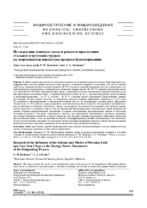| dc.contributor.author | Дьяконов, О. М. | |
| dc.contributor.author | Литвинко, А. А. | |
| dc.coverage.spatial | Минск | ru |
| dc.date.accessioned | 2024-08-07T13:37:14Z | |
| dc.date.available | 2024-08-07T13:37:14Z | |
| dc.date.issued | 2024 | |
| dc.identifier.citation | Дьяконов, О. М. Исследование влияния схемы и режимов прессования стальной и чугунной стружки на энергосиловые параметры процесса брикетирования = Research of the Influence of the Scheme and Modes of Pressing Steel and Cast Iron Chips on the Energy-Power Parameters of the Briquetting Process / О. М. Дьяконов, А. А. Литвинко // Наука и техника. – 2024. – № 4. – С. 279-288. | ru |
| dc.identifier.uri | https://rep.bntu.by/handle/data/147577 | |
| dc.description.abstract | В работе приведены результаты экспериментального исследования процесса горячего брикетирования мелкофракционных отходов черных металлов в пресс-форме с подвижной матрицей. Установлено, что для достижения требуемого значения плотности готовых брикетов 90–95 % (один из основных критериев качества современного металлургического производства) в температурном диапазоне нагрева шихты 700–850 °С давление прессования достигает значений 470–500 МПа. Применение пресс-форм с подвижной матрицей обеспечивает снижение давления и усилия прессования пластичных низко- и среднеуглеродистых сталей до 45 %, высокоуглеродистых малопластичных и труднодеформируемых – до 35 %, чугунов – до 25 %. Удельная работа деформации (энергетические затраты) при нагреве отходов черных металлов до температур неполной горячей деформации снижается в 2,3–2,5 раза. По сравнению с брикетированием в неподвижной матрице при тех же температурах удельная работа деформации снижается на 15–20 %. Процесс деформационного уплотнения дискретного пористого тела протекает при минимальном воздействии сил бокового контактного трения, так как фронт уплотнения (уплотненный слой стружки) перемещается совместно с матрицей в одном и том же направлении при минимальном относительном сдвиге поверхностей трения. Характер деформационного уплотнения и уровень сопротивления деформированию зависят от исходного состояния материала: чем выше пластичность металла, тем интенсивнее увеличивается плотность прессовки; чем больше начальная плотность и предел текучести, тем большее давление прессования необходимо приложить для достижения одного и того же значения плотности. Мелкофракционные добавки металлического или неметаллического происхождения заполняют пустоты между более крупными фракциями стружки и таким образом повышают начальную плотность прессовки и градиент роста давления по мере увеличения плотности. | ru |
| dc.language.iso | ru | ru |
| dc.publisher | БНТУ | ru |
| dc.title | Исследование влияния схемы и режимов прессования стальной и чугунной стружки на энергосиловые параметры процесса брикетирования | ru |
| dc.title.alternative | Research of the Influence of the Scheme and Modes of Pressing Steel and Cast Iron Chips on the Energy-Power Parameters of the Briquetting Process | ru |
| dc.type | Article | ru |
| dc.identifier.doi | 10.21122/2227-1031-2024-23-4-279-288 | |
| local.description.annotation | The paper presents the results of an experimental study of the process of hot briquetting of fine-grained ferrous metal waste in a mold with a movable matrix. It has been established that in order to achieve the required density of finished briquettes of 90–95 % (one of the main quality criteria for modern metallurgical production), in the temperature range of heating the charge of 700–850 °C, the pressing pressure reaches values of 470–500 MPa. The use of molds with a movable matrix ensures reduction in pressure and pressing force of ductile low- and medium-carbon steels up to 45 %, high-carbon, low ductility and difficult to deform - up to 35 %, cast iron – up to 25 %. The specific work of deformation (energy costs) when heating waste ferrous metals to temperatures of incomplete hot deformation is reduced by 2.3–2.5 times. Compared to briquetting in a fixed matrix at the same temperatures, the specific work of deformation is reduced by 15–20 %. The process of deformation compaction of a discrete porous body occurs with minimal impact of lateral contact friction forces, since the compaction front (compacted chip layer) moves together with the matrix in the same direction with minimal relative displacement of the friction surfaces. The nature of deformation compaction and the level of resistance to deformation depend on the initial state of the material: the higher the plasticity of the metal, the more intense the compaction density increases; the higher the initial density and yield strength, the greater the pressing pressure must be applied to achieve the same density value. Fine additives of metallic or non-metallic origin fill the voids between larger fractions of chips and thus increase the initial compaction density and the pressure gradient as density increases. | ru |

